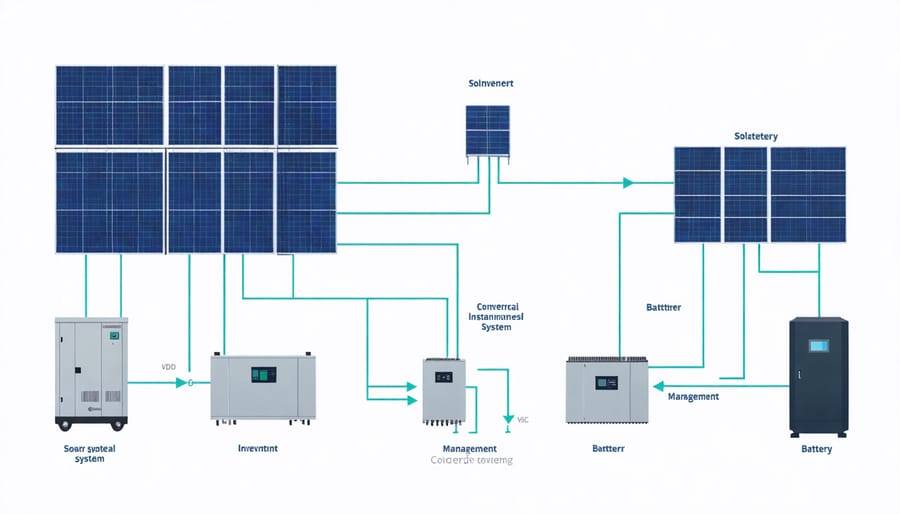Commercial Solar Battery Storage: Power Your Business Growth with Reliable Energy

Commercial solar battery storage systems are revolutionizing how businesses manage their energy consumption and sustainability goals across Europe. These sophisticated energy management solutions combine advanced battery technology with intelligent software to capture, store, and deploy solar power precisely when needed. By integrating battery storage with commercial solar installations, organizations can achieve energy independence, reduce operational costs, and maintain reliable power supply during grid outages.
The growing adoption of commercial solar battery storage reflects a fundamental shift in corporate energy strategy. Modern systems can store excess solar energy generated during peak production hours and release it during periods of high demand or limited sunlight. This capability not only optimizes energy consumption patterns but also provides crucial grid services, including frequency regulation and demand response participation.
For facility managers and business owners, these systems represent a strategic investment in both environmental responsibility and operational resilience. With recent technological advancements and decreasing installation costs, commercial solar battery storage has become an increasingly attractive option for organizations seeking to enhance their energy security while contributing to Europe’s renewable energy transition.
This advanced energy solution enables businesses to:
– Reduce peak demand charges
– Ensure business continuity during power outages
– Maximize self-consumption of solar energy
– Generate additional revenue through grid services
– Meet sustainability targets while improving bottom-line performance
Understanding Commercial Solar Battery Storage Systems
Core Components and Integration
Modern commercial solar battery storage systems comprise three essential components working in harmony. At the heart of these systems are advanced lithium-ion batteries, which have become the industry standard due to their high energy density, longer lifespan, and decreasing costs. These batteries typically offer 10-15 years of reliable service when properly maintained.
Sophisticated inverters form the crucial bridge between your solar panels, batteries, and the power grid. These bi-directional inverters efficiently convert DC power from solar panels into usable AC electricity while managing power flow between different system components. European manufacturers have pioneered hybrid inverter technology, combining solar and battery functions in single, space-saving units.
Intelligent battery management systems provide the operational intelligence, monitoring battery health, optimizing charging cycles, and ensuring safe operation. These systems protect your investment by preventing overcharging and maintaining optimal temperature conditions, while providing real-time performance data through user-friendly interfaces.
Together, these components create a robust energy storage solution that maximizes solar power utilization and ensures reliable backup power for commercial operations.

Scalability and System Sizing
Determining the right size for a commercial solar battery storage system requires careful analysis of several key factors. First, assess your facility’s average daily energy consumption patterns, including peak usage periods and seasonal variations. This baseline data helps establish the minimum storage capacity needed for optimal operation.
Consider your business’s specific goals: Are you aiming for complete energy independence, peak shaving, or primarily backup power? For most commercial installations, a system that covers 60-80% of daily energy needs provides the best balance between investment and returns.
Factor in your available space, budget constraints, and potential future expansion needs. A modular approach allows for scalability, enabling businesses to start with a core system and expand as needed. European regulations often provide incentives for certain system sizes, which may influence your sizing decisions.
For precise calculations, evaluate your peak load requirements, critical equipment power needs, and desired backup duration. Working with qualified energy consultants can help determine the optimal battery capacity, inverter specifications, and solar array size to create a well-balanced, efficient system that meets your current needs while accommodating future growth.
Business Benefits and ROI
Energy Cost Reduction
Commercial solar battery storage systems offer significant financial benefits through cost savings through peak shaving and strategic energy management. By storing excess solar energy during low-demand periods and utilizing it during peak hours, businesses can substantially reduce their electricity costs and grid dependency.
The primary cost reduction mechanism works through demand charge management, where stored energy helps avoid expensive peak-rate periods. During times of high grid electricity prices, typically between 17:00 and 21:00, businesses can switch to their stored solar energy instead of drawing from the grid. This strategic approach can reduce energy bills by 20-30% for most commercial operations.
Battery storage systems also enable participation in demand response programs, where businesses can earn additional revenue by supporting grid stability. By optimizing energy consumption patterns and automatically switching between stored and grid power, these systems create a more efficient energy ecosystem.
Furthermore, businesses can benefit from time-of-use arbitrage, storing cheaper off-peak electricity for use during expensive peak periods. The sophisticated energy management systems included with modern battery storage solutions continuously monitor usage patterns and automatically adjust storage and discharge cycles to maximize cost savings.
When combined with solar PV systems, battery storage provides enhanced financial returns through improved self-consumption rates and reduced grid electricity purchases. This integrated approach ensures businesses can maximize their renewable energy investment while maintaining reliable power supply.

Energy Independence and Reliability
Commercial solar battery storage systems represent a crucial step towards achieving energy independence and enhanced operational reliability for businesses. These systems serve as powerful backup solutions during grid outages, ensuring continuous operations when traditional power sources fail. By storing excess solar energy during peak production hours, organisations can maintain critical functions even during extended power disruptions.
The integration of battery storage systems enables businesses to operate independently from the grid when necessary, providing a reliable power supply during emergencies or periods of grid instability. This capability is particularly valuable for industries where continuous power supply is essential, such as data centres, healthcare facilities, and manufacturing plants.
Modern battery storage solutions offer sophisticated power management features, including automatic switching between grid and stored power, intelligent load distribution, and real-time monitoring capabilities. These systems can be programmed to prioritise critical operations during power outages, ensuring that essential equipment remains functional.
Furthermore, the reliability of commercial solar battery storage extends beyond emergency backup. These systems help stabilise power supply throughout daily operations, smoothing out voltage fluctuations and providing consistent energy quality. This enhanced stability protects sensitive equipment and helps maintain optimal operational efficiency, while reducing dependence on traditional grid infrastructure.
Implementation and Integration
Site Assessment and Planning
A successful commercial solar battery storage installation begins with a thorough site assessment and meticulous planning. The first step involves analysing your facility’s energy consumption patterns, peak demand periods, and load profiles over different seasons. This data forms the foundation for determining optimal battery capacity and system configuration.
Professional engineers conduct detailed structural assessments to verify roof integrity or ground mounting locations for solar panels and battery installation areas. They evaluate available space, weight-bearing capacity, and environmental factors such as shade patterns and local weather conditions that might impact system performance.
Grid connection analysis is crucial, examining your facility’s existing electrical infrastructure and determining necessary upgrades. This includes evaluating transformer capacity, switchgear specifications, and compliance with local grid connection requirements.
The planning phase incorporates designing the system layout, selecting appropriate battery chemistry, and determining inverter specifications. Special consideration is given to safety features, including fire protection systems and ventilation requirements, particularly for indoor installations.
Energy management strategy development follows, outlining how the system will operate to maximise benefits. This includes setting parameters for peak shaving, time-of-use optimisation, and backup power scenarios.
The final planning stage involves securing necessary permits and ensuring compliance with local building codes and electrical regulations. This often requires coordination with local authorities and utility providers.
Throughout the assessment and planning process, sustainability goals and future expansion possibilities are considered, ensuring the system can adapt to changing energy needs. This comprehensive approach helps create a robust foundation for successful system implementation while minimising potential complications during installation and operation.
Installation and Commissioning
The installation and commissioning of commercial solar battery storage systems requires careful planning and execution by qualified professionals. The process typically begins with a detailed site assessment, where engineers evaluate the installation location, electrical infrastructure, and space requirements for both battery units and associated equipment.
Following site approval, the installation team prepares the designated area by establishing proper mounting systems and ensuring adequate ventilation. The battery units are positioned according to manufacturer specifications, with special attention to temperature control and accessibility for maintenance. Critical components such as inverters, energy management systems, and safety equipment are then installed and integrated.
Electrical connections represent a crucial phase, requiring expert technicians to establish proper wiring between the battery system, existing electrical infrastructure, and solar array (if present). This includes installing protection devices, monitoring systems, and communication interfaces for remote management capabilities.
The commissioning process begins once all physical installations are complete. This involves a series of systematic checks and tests to verify system functionality and safety compliance. Engineers conduct performance testing, calibrate monitoring systems, and validate communication protocols. Each component undergoes thorough testing to ensure it operates within specified parameters.
Final commissioning includes operator training, where facility staff receive comprehensive instruction on system operation, monitoring, and basic troubleshooting procedures. Documentation, including as-built drawings, operation manuals, and warranty information, is provided to the facility owner.
The entire installation and commissioning process typically takes between one to three weeks, depending on system size and complexity. Regular system checks during the initial operational period help ensure optimal performance and identify any adjustments needed for peak efficiency.
Maintenance and Performance Optimization

Monitoring and Management
Modern commercial solar battery storage systems rely heavily on sophisticated system performance tracking and management tools to ensure optimal operation. These monitoring solutions typically include real-time data collection, advanced analytics, and automated alert systems that provide comprehensive oversight of your installation.
Key monitoring parameters include battery state of charge, charging and discharging rates, temperature levels, and overall system efficiency. Smart management systems integrate seamlessly with building energy management systems (BEMS), allowing facility managers to optimize energy flows and maximize cost savings.
Remote monitoring capabilities enable both operators and service providers to assess system health, predict maintenance needs, and respond quickly to any performance issues. Many platforms offer user-friendly dashboards accessible via web interfaces or mobile applications, providing clear visualizations of energy production, consumption, and storage patterns.
Predictive maintenance algorithms analyze historical data to anticipate potential issues before they impact system performance. This proactive approach helps maintain system reliability while reducing downtime and maintenance costs. Regular performance reports and efficiency analyses help businesses track their return on investment and identify opportunities for system optimization.
Integration with weather forecasting systems further enhances management capabilities, allowing for intelligent charging and discharging strategies based on expected solar production and energy demand patterns.
Preventive Maintenance
Regular maintenance is crucial for ensuring the optimal performance and longevity of commercial solar battery storage systems. A well-structured maintenance schedule typically includes quarterly inspections and annual comprehensive assessments. During these checks, technicians evaluate battery connection integrity, monitor thermal conditions, and verify system parameters.
Key maintenance tasks include cleaning battery terminals, checking ventilation systems, and inspecting safety equipment. Modern battery management systems (BMS) provide real-time monitoring, but physical inspections remain essential for detecting potential issues before they escalate. Maintenance teams should pay particular attention to temperature regulation systems, as thermal management significantly impacts battery life and efficiency.
European regulations require detailed maintenance logs and safety protocols. Facility managers should maintain records of all maintenance activities, including voltage readings, temperature data, and any corrective actions taken. It’s recommended to schedule maintenance during periods of lower energy demand to minimize operational disruption.
Professional maintenance services often include performance analysis and optimization recommendations. These insights help businesses maximize their return on investment while ensuring system reliability. Most manufacturers recommend replacing battery components after 10-15 years, depending on usage patterns and environmental conditions.
Prevention is more cost-effective than reactive maintenance. Regular upkeep not only extends system lifespan but also maintains optimal charging efficiency and storage capacity, ultimately supporting sustainable energy goals.
Commercial solar battery storage systems represent a pivotal advancement in sustainable energy management for European businesses and industries. Throughout this exploration, we’ve seen how these systems offer compelling benefits: from significant cost reductions and enhanced energy independence to improved grid stability and reduced carbon footprints.
The integration of battery storage with commercial solar installations isn’t just about keeping the lights on – it’s about future-proofing your business against rising energy costs while contributing to Europe’s renewable energy targets. The technology has matured significantly, offering reliable, efficient solutions that can be tailored to various commercial needs and scales.
As energy markets continue to evolve and electricity costs rise, the business case for solar battery storage becomes increasingly compelling. Modern systems offer sophisticated energy management capabilities, seamless grid integration, and substantial return on investment potential through peak shaving and demand charge reduction.
For businesses considering this technology, the time to act is now. With current incentives, improving technology, and growing market maturity, commercial solar battery storage systems present an opportunity to lead in sustainable business practices while securing long-term energy independence. Consider consulting with qualified energy specialists to explore how these systems can benefit your specific commercial operation and contribute to a more sustainable future.
Take the first step towards energy independence and sustainability by evaluating your facility’s potential for solar battery storage integration today.
Leave a Reply